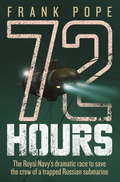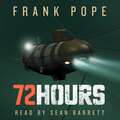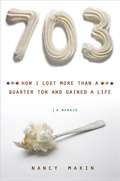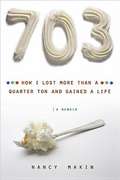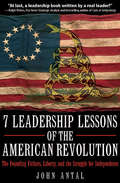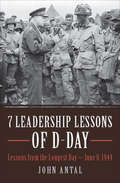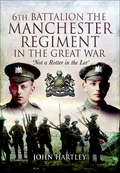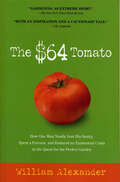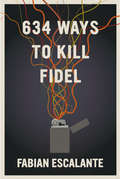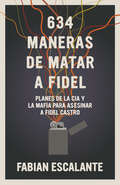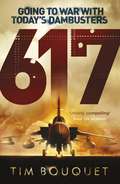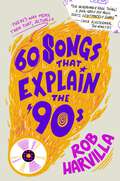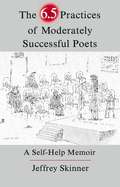- Table View
- List View
72 Hours
by Frank PopeThe Royal Navy's dramatic race to save the crew of a trapped Russian submarine.5 August 2005. On a secret mission to an underwater military installation 30 miles off the coast of Kamchatka, Russian Navy submersible AS-28 ran into a web of cables and stuck fast. With 600 feet of freezing water above them, there was no escape for the seven crew. Trapped in a titanium tomb, all they could do was wait as their air supply slowly dwindled.For more than 24 hours the Russian Navy tried to reach them. Finally - still haunted by the loss of the nuclear submarine Kursk five years before - they requested international assistance. On the other side of the world Commander Ian Riches, leader of the Royal Navy's Submarine Rescue Service, got the call: there was a sub down.With the expertise and specialist equipment available to him Riches knew his team had a chance to save the men, but Kamchatka was at the very limit of their range and time was running out. As the Royal Navy prepared to deploy to Russia's Pacific coast aboard a giant Royal Air Force C-17 airlifter, rescue teams from the United States and Japan also scrambled to reach the area.On board AS-28 the Russian crew shut down all non-essential systems, climbed into thick thermal suits to keep the bone-chilling damp at bay and waited, desperate to eke out the stale, thin air inside the pressure hull of their craft. But as the first of them began to drift in and out of consciousness, they knew the end was close. They started writing their farewells.72 HOURS tells the extraordinary, edge-of-the-seat and real-life story of one of the most dramatic rescue missions of recent years.
72 Hours
by Frank PopeThe Royal Navy's dramatic race to save the crew of a trapped Russian submarine.5 August 2005. On a secret mission to an underwater military installation 30 miles off the coast of Kamchatka, Russian Navy submersible AS-28 ran into a web of cables and stuck fast. With 600 feet of freezing water above them, there was no escape for the seven crew. Trapped in a titanium tomb, all they could do was wait as their air supply slowly dwindled.For more than 24 hours the Russian Navy tried to reach them. Finally - still haunted by the loss of the nuclear submarine Kursk five years before - they requested international assistance. On the other side of the world Commander Ian Riches, leader of the Royal Navy's Submarine Rescue Service, got the call: there was a sub down.With the expertise and specialist equipment available to him Riches knew his team had a chance to save the men, but Kamchatka was at the very limit of their range and time was running out. As the Royal Navy prepared to deploy to Russia's Pacific coast aboard a giant Royal Air Force C-17 airlifter, rescue teams from the United States and Japan also scrambled to reach the area.On board AS-28 the Russian crew shut down all non-essential systems, climbed into thick thermal suits to keep the bone-chilling damp at bay and waited, desperate to eke out the stale, thin air inside the pressure hull of their craft. But as the first of them began to drift in and out of consciousness, they knew the end was close. They started writing their farewells.72 HOURS tells the extraordinary, edge-of-the-seat and real-life story of one of the most dramatic rescue missions of recent years.
72 Hours
by Frank Pope5 August 2005. On a secret mission to an underwater military installation 30 miles off the coast of Kamchatka, Russian Navy submersible AS-28 ran into a web of cables and stuck fast. With 600 feet of freezing water above them, there was no escape for the seven crew. Trapped in a titanium tomb, all they could do was wait as their air supply slowly dwindled.For more than 24 hours the Russian Navy tried to reach them. Finally - still haunted by the loss of the nuclear submarine Kursk five years before - they requested international assistance. On the other side of the world Commander Ian Riches, leader of the Royal Navy's Submarine Rescue Service, got the call: there was a sub down.With the expertise and specialist equipment available to him Riches knew his team had a chance to save the men, but Kamchatka was at the very limit of their range and time was running out.As the Royal Navy prepared to deploy to Russia's Pacific coast aboard a giant Royal Air Force C-17 airlifter, rescue teams from the United States and Japan also scrambled to reach the area.On board AS-28 the Russian crew shut down all non-essential systems, climbed into thick thermal suits to keep the bone-chilling damp at bay and waited, desperate to eke out the stale, thin air inside the pressure hull of their craft. But as the first of them began to drift in and out of consciousness, they knew the end was close. They started writing their farewells.72 HOURS tells the extraordinary, edge-of-the-seat and real-life story of one of the most dramatic rescue missions of recent years.Read by Sean Barrett(p) 2012 Isis Publishing Ltd
703: How I Lost More Than a Quarter Ton and Gained a Life
by Nancy MakinA moving, funny, tongue-in-cheek, and deadly serious story about how one woman lost and found herself by going online. Nancy Makin weighed an astounding 703 pounds in May 2000. She was forty-five years old and had diabetes and heart disease. Thanks in equal parts to shame and logistics, she'd been homebound for a dozen years. But all that changed after a gift from her sister: a computer. A technophobe, Nancy ignored it for months, until finally boredom and curiosity pushed her into cyberspace. And there, in a chat room, she found the friendliness, the support, and even the love she'd been missing for so long. Nobody flinched when Nancy spoke up; people treated her with the same respect accorded to everybody else. Thanks to these emotional connections, Nancy's life was transformed. She followed no diet plan; no pills, potions or ab-crunching exercises played a part. There was no silver bullet, no magical, elusive ingredient-and yet today Nancy has lost more than 530 pounds. Nancy's tale is one of redemption, a story of reevaluating her worth and insisting she had value simply because she was human. It will show a growing America that life is sweet and always worth living.
703
by Nancy MakinNancy Makin weighed an astounding 703 pounds in May 2000. She was forty-five years old and had diabetes and heart disease. Thanks in equal parts to shame and logistics, she'd been homebound for a dozen years. All that changed after her sister gave her a computer. Nancy ignored it for months, until finally boredom and curiosity pushed her into cyberspace. And there, in a chat room, she found the friendliness, the support, and even the love she'd been missing for so long. Nobody flinched when Nancy spoke up; people treated her with the same respect accorded to everybody else. Thanks to these emotional connections, Nancy's life was transformed. She followed no diet plan - no pills, potions or ab-crunching exercises played a part. There was no silver bullet, no magical, elusive ingredient, and yet today Nancy has lost more than 530 pounds. A moving, funny, tongue-in-cheek, and deadly serious story, Nancy's tale is one of redemption, and of reevaluating her worth.
700 Sundays
by Billy CrystalActor and comedian Billy Crystal has forged a highly successful career by portraying other people in movies like When Harry Met Sally...and City Slickers. But in 700 Sundays, a memoir based on his one-man Broadway play of the same name, Crystal tells his own story, dissecting an often complex relationship with his father and how that relationship resonated in other aspects of his life. His father, Jack Crystal was an influential jazz concert promoter and operated an influential jazz record label, affording his son an opportunity to tell stories of being taken to his first movie by Billie Holliday and seeing his grandmother suggest that Louis Armstrong simply "try coughing it up." But Jack died when his son was fifteen years old, soon after a forever-unresolved argument between the two, leaving Billy to cope with crushing grief while simultaneously and perhaps ironically trying to launch a career in comedy. This lends 700 Sundays much needed gravity in a volume that is packed with zingy one-liners and whimsical observations that serve to illustrate the comedy career Crystal forged, while also providing some decent laughs. Interestingly, there is very little reference to the better known accomplishments of Crystal's Hollywood career as the author chooses to focus instead on the seemingly mundane but highly entertaining aspects of his Long Island roots. Though 700 Sundays (the name comes from Crystal's estimation of how many Sundays he got to spend with his father) is packaged here in book form, it reads like a piece of theater and, more specifically, like a selection of memories about a father, lovingly and touchingly re-told by his loving son. --John Moe
7 Leadership Lessons of the American Revolution: The Founding Fathers, Liberty, and the Struggle for Independence
by John Antal<p>“A leadership book written by a real leader! . . . eminently useful for those ‘in command’ of organizations of any kind. A stimulating five-star work” (Ralph Peters, New York Times–bestselling author).<p> <p>This book tells the dramatic story of seven defining leadership moments from the American Revolution, as well as providing case studies that can improve your leadership at home, business, in your community, in the military, or in government.<p> <p>Leadership is not about position, it is about influence. You can be a leader no matter what your rank or position. It is not about power, it is about selflessness. You cannot be a good leader unless you can also be a good follower. Good leaders don’t shine, they reflect. Lessons like these are the core of this book. The stories in this book are about leaders who were challenged at all corners, adapted, improvised and overcame. The tales of leaders like Samuel Adams, Patrick Henry, Henry Knox, Benjamin Franklin, and George Washington, to name a few, are stories you will want to know and tell. These leaders knew how to push teams to succeed under the toughest conditions. These stories will come alive on the pages of this book to fuel your leadership fire and make you a better leader in any endeavor. Learn how they secured our liberty so you can transform today into a better tomorrow.<p>
7 Leadership Lessons of D-Day: Lessons from the Longest Day—June 6, 1944
by John Antal<p>“Drawing universal truths from urgent battlefield crises, the author provides a terrific guide and training tool for leaders at all levels” (Ralph Peters, New York Times–bestselling author).<p> <p>The odds were against the Allies on June 6, 1944. The task ahead of the paratroopers who jumped over Normandy and the soldiers who waded ashore onto the beaches, all under fire, was colossal. In such circumstances, good leadership can be the deciding factor of victory or defeat. This book is about the extraordinary leadership of seven men who led American soldiers on D-Day and the days that followed. Some of them, like Eisenhower, Theodore Roosevelt Jr., and Lt. Dick Winters, are well known, while others are barely a footnote in the history books.<p> <p>This book is not a full history of D-Day, nor does it cover the heroic leadership shown by men in the armies of the Allies or members of the French Resistance, who also participated in the Normandy assault and battles for the lodgment areas. It is, however, a primer on how you can lead today, no matter what your occupation or role in life, by learning from the leadership of these seven figures.<p> <p>A critical task for every leader is to understand what leadership is. Socrates once said that you cannot understand something unless you can first define it in your own words. This book provides the reader with the means to define leadership by telling seven dramatic, immersive, and memorable stories that the reader will never forget.<p>
The 7
by Keith Ablow Glenn BeckRadio and television host Glenn Beck has experienced the rollercoaster of life like few others. From the suicide of his mother when he was just thirteen, to his eventual alcoholism, depression, divorce, unemployment, and health scares--Glenn has weathered life's darkest storms.Any one of those struggles could've ruined him, yet Glenn was able to keep moving forward. He saw past the darkness into the light; past his grief and addictions and into what his life could be.YOU CAN DO IT TOOThe process of finding happiness through personal redemption was not easy, but it left Glenn with a blueprint for how to confront future adversity. Glenn is living proof that these steps--he calls them wonders--don't just work on paper. They helped transform his life and can they can help to transform yours as well. THE 7 WONDERSGlenn Beck and Dr. Keith Ablow--two of the most popular and influential personalities in American media today--have joined forces to present a powerful guide to personal transformation and fulfillment that is as unique as their own unlikely partnership. They are called the "7 Wonders" and they can be used by anyone who has made the decision that they are ready to change their life.After the television talk show host and the bestselling psychiatrist struck up a fast friendship they realized that their experiences with life's struggles were complementary. What Keith had studied, Glenn had lived. What Keith had counseled patients on for years, Glenn had suffered through for decades.The deeply personal insights they shared brought them to realize that their life stories had seven key principles in common; seven wonders that seemed to be essential ingredients for anyone attempting to transform their life. Where does the courage to persevere come from when everything seems hopeless? Why is it nearly impossible to succeed without faith? How much do family and friendships matter in our journey? How do we break down our walls and reveal our inner truths? What does having compassion really mean? How do you tell real friends apart from those who are holding you back? If there's no one to blame for my past, what do you do with your anger and resentment? These kinds of questions are the starting point toward fundamentally changing how you view past damaging relationships, toward breaking the debilitating grip of addiction and depression, toward injecting life with new meaning and purpose and toward helping you embark on a new journey based on hope, strength, and personal empowerment.As you unwrap each of the seven wonders for yourself, you'll discover exactly what Glenn Beck found as he transformed his own life from darkness to light, from dead ends to endless possibilities, from addiction to freedom: it doesn't take a superhero to find the strength to change--it just takes the courage to take the first step. This book, which was only possible by combining together decades of personal struggle with world-class professional experience, can be that first step for you.The 7 Wonders grows out of a unique friendship that we've developed over the last five-years. It is unique because it brought together a psychiatrist who naturally burrows toward the truth, and a recovering addict who spent decades running from it.As we spent more time together we began to let our guards down. Over time we reached a level of honesty with each other that is rare. As a result, we learned that the principles that have guided the well-honed healing techniques of one of us are precisely the same principles that instinctively guided the other to replace nearly unbearable pain with genuine happiness.We believe that it was God's plan for us to meet; that it was God's plan for us to speak so openly with one another; and it was God's plan that we share with you the seven wonders we discovered together.We also firmly believe that it was God's plan that this book now finds you at this exact moment in your life. --Glenn Beck & Dr. Keith Ablow
6th Battalion, The Manchester Regiment in the Great War
by John HartleyThe 6th Battalion, The Manchester Regiment, was a prewar Territorial unit. Many of its members held white collar positions employed by the Citys legal, financial and stockbroking practices or worked for the major commercial organizations trading and manufacturing cotton goods. It went overseas in September 1914, taking with it many new recruits who would undertake their basic training whilst the Battalion formed part of the British garrison in Egypt.It saw action at Gallipoli from May 1915 until the evacuation at the end of the year and fascinating campaign is dealt with in considerable detail. The Battalion returned to Egypt until the spring of 1917 when it moved to France.The Manchesters saw regular action for most of 1918, coming under attack in the German offensive in March. Throughout the summer and autumn, the Battalion took part in the Advance to Victory and was still advancing when the Armistice was signed in November.The book also recounts the history of the second line battalion, the 2/6th Manchesters, from its inception in 1914 until it was all but destroyed in March 1918.The author draws on official records and personal accounts to tell the story of these fine battalions.
69 Exhibition Road: Twelve True-Life Tales from the Fag End of Punk, Porn & Performance
by Dorothy Max PriorA vibrant, wry, and engaging account of life as an adventurous, queer young person in late 1970s London discovering themselves as an artist, and an individual.While working as a photographer&’s model, gallery usher, and exotic dancer, Dorothy &“Max&” Prior witnessed the births of Adam and the Ants, The Monochrome Set, The Sex Pistols, and Throbbing Gristle, as well as drumming in her own cult band Rema Rema and recording with Industrial Records. Her exuberant commentaries, each presented as a stand-alone episode, illustrate the multilayered nature of the London music, art, and fashion worlds of the late 1970s, and the overlap between the early punk scene with the city&’s rapidly evolving club and queer cultures.
The $64 Tomato: How One Man Nearly Lost His Sanity, Spent a Fortune, and Endured an Existential Crisis in the Quest for the Perfect Garden
by William AlexanderThis “wildly entertaining” memoir recounts the joys—and horrors—of trying to grow your own food (The Boston Globe). Bill Alexander had no idea that his simple dream of having a vegetable garden and small orchard in his backyard would lead him into life-and-death battles with groundhogs, webworms, weeds, and weather; midnight expeditions in the dead of winter to dig up fresh thyme; and skirmishes with neighbors who feed the deer and other vermin. Not to mention the vacations that had to be planned around the harvest, the near electrocution of the tree man, the limitations of his own middle-aged body, and the pity of his wife and kids. When Alexander runs a cost-benefit analysis, adding up everything from the live animal trap to the Velcro tomato wraps, and then amortizing it over the life of his garden, it comes as quite a shock to learn that it cost a staggering $64 to grow each one of his beloved Brandywine tomatoes. But as any gardener will tell you, you can’t put a price on the unparalleled pleasures of providing fresh food for your family. “Engaging, funny, and down-to-earth.” —Entertainment Weekly “A hilarious horticultural memoir.” —Publishers Weekly, starred review “A delightful guide to achieving gardening bliss.” —Minneapolis Star-Tribune
634 Ways to Kill Fidel
by Fabian EscalanteA sprawling account of the various, creative, often bizarre, yet incredibly disturbing attempts to assassinate Fidel Castro. Soon to be a TV series from Jed Mercurio, show runner for "The Bodyguard," and Richard Brown, producer of "True Detective" and "Catch-22."Fabián Escalante, the founder of the Cuban intelligence services, and head of the Cuban State Security Department, provides a clear-eyed first-person account of his experiences defending Fidel Castro from the extraordinary attempts to take his life. From lethal poisons to plastic explosives to bazookas, Escalante introduces and describes an array of assassination plots and historical figures and depicts the ensuing cat-and-mouse game in the midst of the Cold War. Written in the style of a political thriller yet based on real events, 634 Ways to Kill Fidel Castro is a well-researched and documented series of vignettes put together by multiple investigations in Cuba and the experiences of the author, who participated in several of them; dozens of interviews with participants; extensive documentary evidence; and the collaboration of officials, and undercover agents who dismantled these plots. Filled with harrowing stories of deceitful FBI tactics such as moles who infiltrated the revolutionary Cuban government and gained a reputation with them with the ultimate goal of bombing their military bases. As well as undercover attempts to give Fidel poison laced cigars, Escalante takes the reader from DC to New York, Miami to Havana and uncovers the intricate conspiracy to silence dissent and kill Fidel Castro. 634 Ways to Kill Fidel Castro is filled to the brim with historical details on the CIA, Cuba, the communist movement, US government officials, and Fidel himself. Escalante&’s first-hand account provides evidence of the lengths to which the CIA went through to assassinate Fidel Castro and the determined efforts to protect him and what he stood for.
634 Maneras de matar a Fidel: Planes de la CIA y la Mafia para asasinar a Fidel Castro
by Fabian EscalanteExpansivo recuento de los diversos, creativos, frecuentemente extraños y sin embargo increíblemente inquietantes intentos de asesinar a Fidel Castro.Fabián Escalante, el fundador de los servicios de seguridad cubanos y jefe del Departamento de Seguridad del Estado Cubano provee un lúcido recuento en primera persona de sus experiencias defendiendo a Castro contra extraordinarios intentos de homicidio. Escrito en el estilo de una novela de suspenso político, pero lleno de detalles históricos sobre Fidel, Cuba, el movimiento comunista y los intentos de Estados Unidos de silenciar la rebelión, este libro clarifica los peligros inherentes que conlleva luchar por un mundo mejor.634 maneras de matar a Fidel ilumina la amenaza que Castro y el movimiento revolucionario cubano presentaban para la hegemonía estadounidense. El resultado es un inquietante retrato de cómo los impuestos de ciudadanos estadounidenses financian campañas para reprimir el disentimiento e intentar quebrar movimientos en el Sur Global que luchan por la soberanía, la justicia, la autodeterminación y, básicamente, un mundo mejor."Planes de asesinato concebidos contra Fidel Castro a lo largo de muchos años involucraron armas tales como venenos letales, potentes explosivos plásticos, cigarros conteniendo sustancias peligrosas, granadas a lanzar en espacios públicos, armas con telescopios sofisticados, jeringas llenas de veneno con agujas tan finas que el contacto con la piel pasaría desapercibido, lanzadores de misiles y bazucas, y cargas explosivas escondidas en caños bajo tierra con un temporizador contando los minutos y segundos hasta la explosión."
62: Aaron Judge, the New York Yankees, and the Pursuit of Greatness
by Bryan Hoch&“The definitive story&” (Tyler Kepner, The New York Times baseball columnist) of Yankees slugger Aaron Judge&’s incredible, unparalleled run to break Roger Maris&’s home run record and the franchise both men called home.Aaron Judge, the hulking superman who carried an easy aw-shucks demeanor from small-town California to stardom in the Big Apple, had long established his place as one of baseball&’s most intimidating power hitters. Baseballs frequently rocketed off his bat like cannon fire, dispatching heat-seeking missiles toward the &“Judge&’s Chambers&” seating area in right field, sending delirious fans scattering for souvenirs. But even in a high-tech universe where computers measure each swing to the nth degree, Roger Maris&’s American League mark of sixty-one home runs seemed largely out of reach. It had been more than a decade since baseball wiped clean the stains of its performance-enhanced era, in which cartoonish sluggers Mark McGwire, Sammy Sosa, and Barry Bonds made a mockery of the record book. Given a more level playing field against pitchers sporting hellacious arsenals unlike anything Babe Ruth or Maris could have imagined, only an exceptional talent could even consider making a run at sixty-one homers. Judge, who placed the bet of his life by turning down a $213.5 million extension on the eve of the regular season, promised to rise to the challenge. &“In the most thorough telling yet of an all-time-great Yankees performance&” (Jeff Passan, New York Times bestselling author), veteran Yankees beat reporter Bryan Hoch unravels the remarkable journey of Judge&’s run to shatter Maris&’s beloved sixty-one-year-old record. In-depth, inspiring, and with an expert&’s insight, 62 also investigates the more significant questions raised in a season unlike any other, including how—and where—Judge will deliver his encore.
617: Going to War with Today's Dambusters
by Tim BouquetThe inside story of today's Dambusters, 617 Squadron RAF, at war in Afghanistan.In May 1943, 617 Squadron RAF executed one of the most daring operations in military history as bombers mounted a raid against hydro-electric dams in Germany. 617 Squadron became a Second World War legend. Nearly 70 years later, in April 2011, a new generation of elite flyers, now flying supersonic Tornado GR4 bombers, was deployed to Afghanistan - their mission: to provide close air support to troops on the ground.Tim Bouquet was given unprecedented access to 617's pre-deployment training and blistering tour in Afghanistan. From dramatic air strikes to the life-and-death search for IEDs and low-flying shows of force designed to drive insurgents from civilian cover, he tracked every mission - and the skill, resilience, banter and exceptional airmanship that saw 617 through.
617: Going to War with Today's Dambusters
by Tim BouquetIn May 1943, 617 Squadron RAF executed one of the most daring operations in military history. Flying barely 50 feet above black marble waters, Wing Commander Guy Gibson and his bombers mounted a raid against hydro-electric dams in Germany. Bold, courageous and precise - 617 Squadron became a World War II legend. Nearly seventy years later in April 2011, a new generation of elite flyers followed their Dambuster heroes into the theatre of war. Now flying supersonic Tornado GR4 bombers, 617 Squadron was deployed to Kandahar, Afghanistan - their mission, to provide close air support to troops engaged in brutal conflict on the ground. Commanding 617 is new boss Keith Taylor. An operational veteran with seven tours over Iraq, he knew that even with the latest cutting-edge weapons and sensors, only rigorous flying standards and watertight tactics would keep his young pilots safe. A full-throttle account of daring feats in modern fast attack jets, this is also a very personal story of a closely-knit band of men and women working under immense pressure, where every decision could affect the lives of NATO troops and an entire country's hopes for a better future. Tim Bouquet was given unprecedented access to 617's pre-deployment training at RAF Lossiemouth and blistering tour in Afghanistan. From dramatic air strikes to the life-and-death search for IEDs and low-flying shows of force designed to spook and drive insurgents from civilian cover, he tracks every mission - and the skill, resilience, banter and exceptional airmanship that see 617 through. 617 is the richest, most insightful and gripping account of the Royal Air Force at war for a generation.
60 Songs That Explain the '90s
by Rob HarvillaNAMED A BEST MUSIC BOOK OF 2023 by PITCHFORK, VARIETY, AND ROLLING STONE A companion to the #1 music podcast on Spotify, this book takes readers through the greatest hits that define a weirdly undefinable decade. The 1990s were a chaotic and gritty and utterly magical time for music, a confounding barrage of genres and lifestyles and superstars, from grunge to hip-hop, from sumptuous R&B to rambunctious ska-punk, from Axl to Kurt to Missy to Santana to Tupac to Britney. In 60 SONGS THAT EXPLAIN THE '90s, Ringer music critic Rob Harvilla reimagines all the earwormy, iconic hits Gen Xers pine for with vivid historical storytelling, sharp critical analysis, rampant loopiness, and wryly personal ruminations on the most bizarre, joyous, and inescapable songs from a decade we both regret entirely and miss desperately.
60 Postcards
by Rachael ChadwickThe heartfelt and uplifting story of how a project to scatter 60 Postcards in memory of her mother helped a young girl come to terms with her loss.On 11 February 2012 Rachael Chadwick lost her Mother to cancer, just sixteen days after first being diagnosed, and her world shattered right in front of her. Utterly fed up of the milestones and reminders, in December of that year she decided she would do something different and created a project based around her Mum's approaching 60th Birthday. Desperate to spread the word about the wonderful person she had lost, Rachael had the brainwave of leaving notes around a city in her memory. Deciding she would take it a step further she wondered what would happen if she could ask people to respond to her? Full of hope and energy she hand-wrote sixty postcards, each with her email address at the bottom asking the finder to get in touch. But one question remained, where should she go? Knowing how much she longed to visit Paris, the last gift that Rachael's mum had given her was Eurostar vouchers, and so it seemed fitting that this would be her chosen city. So off she went with a group of friends to celebrate, discover, and to scatter her memories. Filling their time in Paris with sight-seeing, food and drink, laughter, and of course postcards. When Rachael returned to her London home, she desperately tried to switch off, switch off from the wondering (and hoping) whether she might actually hear from a postcard finder. And then, they started flowing in...
60 años de soledad: La vida de Carlota después del Imperio Mexicano
by Gustavo VázquezCarlota pasó de un cuento de hadas a un infierno. Ésta es la historia de ese infierno. La emperatriz volvió a ser princesa. Después de que su marido fuera fusilado en el Cerro de las Campanas, la consentida, la enamorada, se convirtió en una paria de las monarquías europeas y pasó sesenta años en la locura. Esta obra es la primera que se concentra en las seis décadas que Carlota de Sajonia-Coburgo-Gotha vivió después de que se derrumbara el Segundo Imperio Mexicano, y ofrece un estudio lúcido de uno de los personajes más apasionantes en la historia del país. Aquí hablan los diarios de los médicos de Carlota, los papeles de Adrien Goffinet (administrador de sus bienes), testigos de aquellos años, archivos reales, las cartas de su servidumbre, bitácoras de viajeros y la prensa europea de la época. Paso a paso, se revela cómo la "princesa más triste del mundo" terminó convertida en un peón. Y cómo, de las ruinas del México de Maximiliano, surgió el imperio privado del rey belga Leopoldo II en el Congo.
60 años de soledad: La vida de Carlota después del Imperio Mexicano
by Gustavo VázquezCarlota pasó de un cuento de hadas a un infierno. Ésta es la historia de ese infierno. La emperatriz volvió a ser princesa. Después de que su marido fuera fusilado en el Cerro de las Campanas, la consentida, la enamorada, se convirtió en una paria de las monarquías europeas y pasó sesenta años en la locura. Esta obra es la primera que se concentra en las seis décadas que Carlota de Sajonia-Coburgo-Gotha vivió después de que se derrumbara el Segundo Imperio Mexicano, y ofrece un estudio lúcido de uno de los personajes más apasionantes en la historia del país. Aquí hablan los diarios de los médicos de Carlota, los papeles de Adrien Goffinet (administrador de sus bienes), testigos de aquellos años, archivos reales, las cartas de su servidumbre, bitácoras de viajeros y la prensa europea de la época. Paso a paso, se revela cómo la "princesa más triste del mundo" terminó convertida en un peón. Y cómo, de las ruinas del México de Maximiliano, surgió el imperio privado del rey belga Leopoldo II en el Congo.
The $60,000 Dog: My Life with Animals
by Lauren SlaterA stunning new book about the role of animals in our lives, by a popular and acclaimed writer From the time she is nine years old, biking to the farmland outside her suburban home, where she discovers a disquieting world of sleeping cows and a "Private Way" full of the wondrous and creepy creatures of the wild--spiders, deer, moles, chipmunks, and foxes--Lauren Slater finds in animals a refuge from her troubled life. As she matures, her attraction to animals strengthens and grows more complex and compelling even as her family is falling to pieces around her. Slater spends a summer at horse camp, where she witnesses the alternating horrific and loving behavior of her instructor toward the animals in her charge and comes to question the bond that so often develops between females and their equines. Slater's questions follow her to a foster family, her own parents no longer able to care for her. A pet raccoon, rescued from a hole in the wall, teaches her how to feel at home away from home. The two Shiba Inu puppies Slater adopts years later, against her husband's will, grow increasingly important to her as she ages and her family begins to grow. Slater's husband is a born skeptic and possesses a sternly scientific view of animals as unconscious, primitive creatures, one who insists "that an animal's worth is roughly equivalent to its edibility." As one of her dogs, Lila, goes blind and the medical bills and monthly expenses begin to pour in, he calculates the financial burden of their canine family member and finds that Lila has cost them about $60,000, not to mention the approximately 400 pounds of feces she has deposited in their yard. But when Benjamin begins to suffer from chronic pain, Lauren is convinced it is Lila's resilience and the dog's quick adaptation to her blindness that draws her husband out of his own misery and motivates him to try to adjust to his situation. Ben never becomes a true believer or a die-hard animal lover, but his story and the stories Lauren tells of her own bond with animals convince her that our connections with the furry, the four-legged, the exoskeleton-ed, or the winged may be just as priceless as our human relationships. The $60,000 Dog is Lauren Slater's intimate manifesto on the unique, invaluable, and often essential contributions animals make to our lives. As a psychologist, a reporter, an amateur naturalist, and above all an enormously gifted writer, she draws us into the stories of her passion for animals that are so much more than pets. She describes her intense love for the animals in her life without apology and argues, finally, that the works of Darwin and other evolutionary biologists prove that, when it comes to worth, animals are equal, and in some senses even superior, to human beings.From the Hardcover edition.
6 Below: Miracle on the Mountain
by Davin Seay Eric LemarqueIn this riveting first-person account, former Olympian and professional hockey player Eric LeMarque tells a harrowing tale of survival—of how, with only a lightweight jacket and thin wool hat, he survived eight days stranded in the frozen wilderness after a snowboarding trip gone horribly wrong. Known by his National Guard rescuers as “the Miracle Man,” Eric recounts his rise to success and fame as a hockey player and Olympian, his long and painful fall due to crystal meth addiction, and his unbelievable ordeal in the wilderness. In the end, a man whose life had been based on athleticism would lose both his legs to frostbite and had to learn to walk—and snowboard—again with prosthetics. He realized that he couldn’t come to terms with his drug addiction or learn to walk again by himself. He had to depend on God for his strength. Now an inspirational speaker committed to raising awareness for the dangers of drugs and crystal meth, Eric, in 6 Below, confronts the ultimate test of survival: what it takes to find your way out of darkness, and—after so many lies—to tell the truth and, by the grace and guidance of God, begin to live again.
The 6.5 Practices of Moderately Successful Poets
by Jeffrey SkinnerA private eye turned moderately successful poet leads readers on a satiric, hopeful tour of how to make a life in the arts, while still having a life. Revealing, hilarious, and peppered with sly takes on the ins and outs of contemporary American poetry (chapters include "The Silence of the Iambs," "The Revisionarium, Ask Dr. Frankenpoem," and "The Periodic Table of Poetic Elements"), Jeffrey Skinner offers advice, candor, and wit.Revision is the process a poem endures to become its best self.Or, if you are the poet, you are the process a poem endures to become its best self.Endures because a first draft, like all other objects in the universe, has inertia and would prefer to stay where it is. The poet must not collaborate.Best self because the poem is more like a person than a thing, and does not strenuously object to personification.Yo, poem.But let's not get carried away. It's your poem and you can treat it as you wish; sweet talk it; push it around if that's what it takes. Alfred Hitchcock notoriously said of the actors in his movies, "They are cattle."Jeffrey Skinner is the author of five books of poetry, most recently Salt Water Amnesia (Ausable Press, 2005). His poems have appeared in The New Yorker, The Atlantic, The Nation, The American Poetry Review, Poetry, BOMB, and The Paris Review, and his work has earned awards from the National Endowment for the Arts, The Ingram Merrill Foundation, and the Howard Foundation.
6,000 Miles of Fence: Life on the XIT Ranch of Texas
by Cordia Sloan DukeThe fabulous XIT Ranch has been celebrated in song, story, and serious history. This book of reminiscences of old XIT cowmen puts on record the everyday life of the individuals who made the ranch run.During her years as a ranch wife, Cordia Sloan Duke wrote a diary; excerpts from her written recordings are here brought together with the reminiscences of the ranch hands. Their forthright, yet picturesque, discussion of ranching hardships and dangers dissipates Hollywood and TV glamorizing, and instead they relate in honest cowboy language what actually happened inside the XIT’s 6,000 miles of fence.“Joe Frantz, one of Texas’ most able writers, has taken the diary of Mrs. Cordia Sloan Duke, widow of XIT’s division manager, plus the terse and pithy reminiscences she collected from former XIT cowboys, and turned them into a unique, readable and realistic account of the cowboy’s way of life.”—New York Times Book Review“This book, with all the merit of being an organized and beautifully presented story, is more than a social history; it is source material, resting on the firm bedrock of first-hand accounts. Hence, while it joins in many libraries and collections several shelves of other cowboy books, it will always be on the top shelf with a select few that have made real contributions to the history of the American West. As a man should be measured by his own standards, and an event in terms of its own time, a book should be evaluated in relation to its purpose. By this standard, as well as by comparison with other books in its library classification, 6,000 Miles of Fence is a success.”—Southwestern Historical Quarterly
